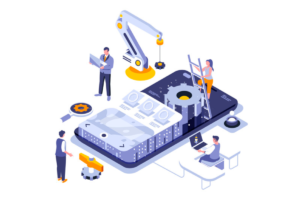From Admin to Developer: Building a Career in Salesforce
Salesforce has become one of the most powerful Customer Relationship Management (CRM) platforms, used by businesses worldwide to manage customer interactions, streamline processes, and drive growth. With Salesforce’s growing dominance, careers in the Salesforce ecosystem have skyrocketed, offering numerous opportunities for both beginners and experienced professionals. For those starting as a Salesforce Administrator and looking to transition to a Developer role, the path may seem daunting but is highly achievable with the right approach.
Visit – Salesforce Classes in Pune
Why Transition from Admin to Developer?
Salesforce Administrators play a crucial role in customizing the platform, managing users, and maintaining the system. However, the scope of an Administrator is often limited to declarative (click-based) tools like workflows, validation rules, and reports. Transitioning to a Developer role opens the door to coding, more complex customizations, and deeper control over Salesforce functionality through programmatic development. Salesforce Developers work with Apex (Salesforce’s proprietary language), Visualforce, Lightning Web Components, and APIs, allowing them to create custom applications, integrations, and more sophisticated automation.
A Developer role often comes with higher responsibilities, more technical work, and better compensation, making it an attractive career progression for those who want to dive deeper into the technical side of Salesforce.
Steps to Transition from Admin to Developer
- Strengthen Your Foundation: As an Administrator, you likely have a solid understanding of Salesforce’s core features, such as user management, security, and process automation. To become a Developer, it’s essential to build on this knowledge by diving deeper into Salesforce architecture, data models, and key elements like objects, fields, and relationships. These are the building blocks of both declarative and programmatic solutions.
- Learn Salesforce Development Languages: Salesforce development primarily revolves around Apex and Visualforce, with the growing popularity of Lightning Web Components (LWC). Begin by learning Apex, which is similar to Java and used for backend logic like triggers and classes. Visualforce is used for creating custom user interfaces, while Lightning Web Components enable modern, dynamic front-end development.
There are numerous free resources available on Trailhead, Salesforce’s official learning platform, which offers hands-on training and projects to help you understand these languages. You can start with beginner Apex tutorials and gradually work on building more complex solutions. - Understand Object-Oriented Programming (OOP): Salesforce development relies heavily on object-oriented programming principles. If you are not familiar with OOP, learning the basics is essential. Understand key concepts like classes, objects, inheritance, and polymorphism, which are the foundation of efficient Salesforce code.
Visit – Salesforce Course in Pune
- Work on Projects and Practice: The transition from Admin to Developer isn’t just about learning theory. Hands-on experience is crucial. Start by working on small projects, like writing Apex triggers to automate tasks that can’t be done through declarative tools or creating custom interfaces using Lightning Components. Contribute to your company’s Salesforce instance by suggesting custom solutions or working on side projects.
- Many aspiring Developers also participate in Salesforce Trailblazer Community projects or hackathons to get real-world experience. You can also explore open-source projects on platforms like GitHub to understand how developers structure their code and build custom solutions.
- Earn Salesforce Certifications: Salesforce certifications are valuable credentials that showcase your skills and knowledge. After obtaining your Salesforce Administrator certification, aim for the Platform Developer I certification. This exam validates your ability to build custom applications using Apex and Visualforce and is the first step toward advanced development roles. As you gain more experience, consider pursuing the Platform Developer II certification, which covers more complex topics like integrations and advanced development practices.
Career Opportunities and Growth
The demand for Salesforce Developers is at an all-time high, as businesses increasingly look to customize Salesforce to meet their unique needs. By transitioning from Admin to Developer, you not only expand your skill set but also significantly enhance your earning potential and job prospects. Salesforce Developers often work on complex, high-impact projects and are in demand across various industries, including finance, healthcare, retail, and more.
Many professionals who make this transition eventually grow into roles like Technical Architect, Solution Architect, or Salesforce Consultant, providing strategic guidance on large-scale Salesforce implementations.
Visit – Budget-Friendly Tips for Building a Fashion Designer’s Toolkit
Conclusion
Transitioning from Salesforce Administrator to Developer is an exciting and rewarding journey that requires dedication, continuous learning, and hands-on experience. By strengthening your foundational knowledge, mastering coding languages like Apex, and working on real-world projects, you can successfully make this career leap and unlock new opportunities in the Salesforce ecosystem.














Post Comment